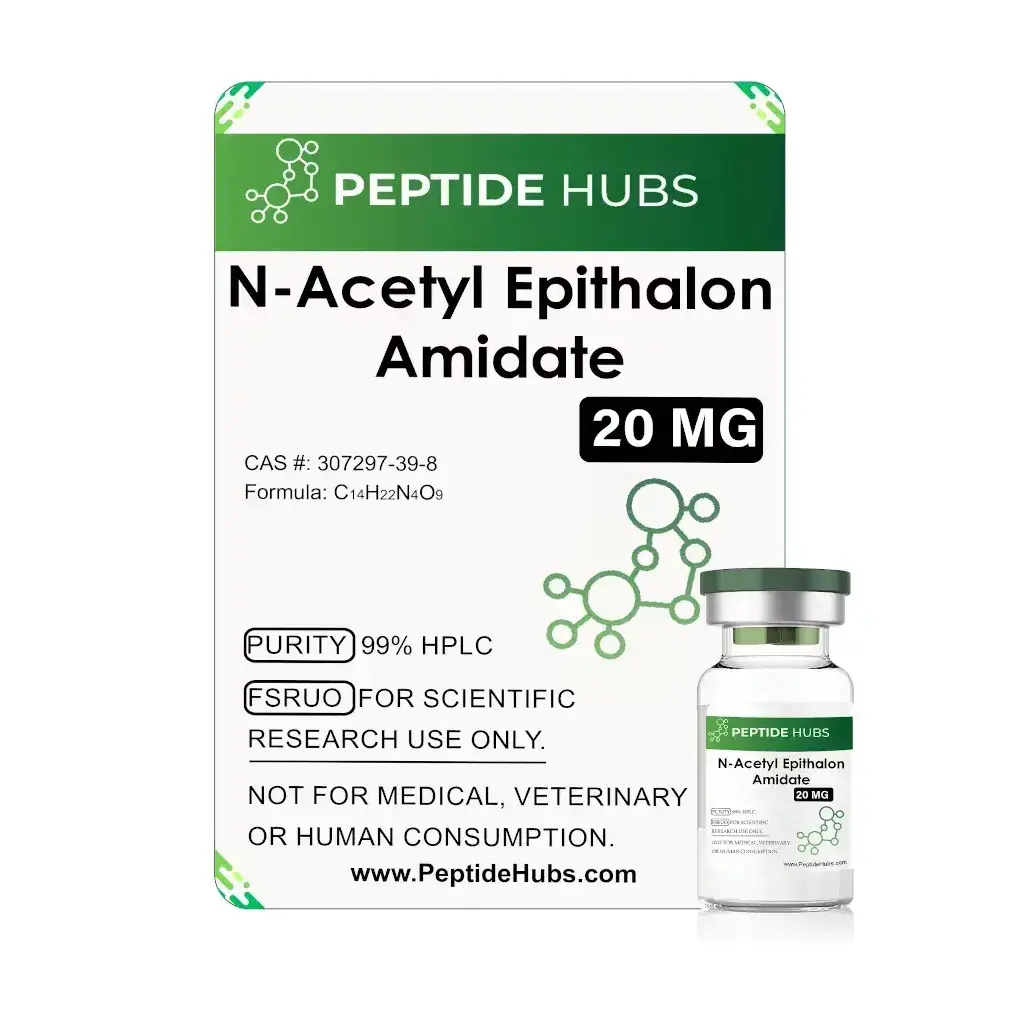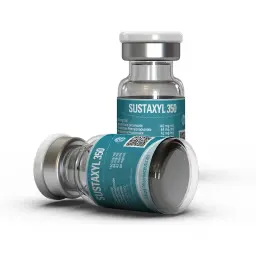


For Subcutaneous Injection
Composition: N-Acetyl Epithalon Amidate
Dosage: 20 mg/vial
Unit: 2 mL Multidose Vial
Form: Lyophilized Powder
Manufactured by Peptide Hubs
Peptide Hubs N-Acetyl Epithalon Amidate 20 mg is a lyophilized research preparation supplied in a sterile 2 mL vial for qualified laboratory use. This presentation focuses on an acetylated, amidated analog of the pineal-derived peptide family commonly discussed in experimental literature for aging-adjacent and cellular-homeostasis modeling under tightly controlled conditions. The 20 mg fill size offers enough headroom for multi-arm pilots, replication runs, and longer timelines while maintaining consistent handling across sessions—ideal for labs that value reproducibility, inventory control, and clear audit trails.
Important: All details on this page are provided for educational discussion within a lawful research setting. This product is not a drug, food, or cosmetic and is not intended to diagnose, treat, cure, or prevent any disease. Purchase and use assume qualified individuals or laboratories operating under applicable regulations and their internal standard operating procedures (SOPs).
Pineal-origin peptides are explored in test systems for their potential roles in cellular balance, stress adaptation, and clock-related signaling. When building background sections or choosing endpoints, many researchers consult general primers on telomere biology and cellular aging as a framing device. For an accessible overview used in study design context, see the NCBI/Bookshelf review on telomere structure and function here. While that primer does not prescribe lab practice, it helps teams select sampling windows, define outcome families, and plan the timing rules that keep data interpretable.
The 20 mg vial is designed for method development and longer protocols where minimizing lot changes and reducing reconstitution events are priorities. Compared with smaller fills, 20 mg supports:
Clarity begins with consistency. Establish a run-in baseline to stabilize confounders—sleep duration and quality, caloric intake, macronutrient distribution, hydration, stimulant/caffeine intake, and training load. Then lock administration clocks (relative to meals, training, and lights-out) directly into the SOP with checklist items for every operator. If your audience includes bodybuilders or fitness enthusiasts, standardize body-composition and recovery proxies (same device, same time of day, same clothing, same ambient conditions) to minimize noise.
In programs that examine cellular-adaptation or recovery-adjacent proxies, protocol hygiene matters more than volume. Use labeled racks, pre-printed session sheets, and a single micro-measurement scheme throughout the study. If you plan staged pilots (e.g., timing A vs. timing B), run them as separate arms rather than stacking conditions in one arm—this keeps your comparisons clean and publication-ready.
Timing: Define the administration-to-meal and administration-to-training intervals in minutes, then keep them unchanged across all test days. If acute sampling is part of the plan, pre-specify exact timepoints (e.g., +15, +30, +60 minutes) and use synchronized timers.
Confounders: Stabilize total calories, macro split, hydration, stimulant intake, and training volume/density. For athlete cohorts, log session RPE, total workload, and rest so downstream analysis can contextualize outliers.
Integrity: Maintain a session checklist: vial ID/lot number, reconstitution date and solvent/volume, final concentration, aliquot size, timestamps, temperature logs, device calibrations, and operator initials. Document deviations (missed sample, temperature excursion) immediately. This audit trail simplifies pilot replication and supports manuscript-quality reporting.
Peptide Hubs emphasizes careful sourcing, clear labeling, and protective packaging suited for USA transit. The catalog is organized to help you design separate, mechanism-specific programs rather than stack endpoints into a single arm—an approach favored by experienced buyers who prioritize clean, reproducible data. For researchers searching "Buy N-Acetyl Epithalon Amidate USA" and "Peptide Hubs N-Acetyl Epithalon Amidate," this 20 mg vial supports concentrated stocks, consistent aliquoting, and efficient multi-arm execution.
Teams that want longer timelines, minimal reconstitution events, and repeatable handling tend to prefer the 20 mg fill. It provides the bandwidth to run A/B timing windows and replicate pilots from the same lot—especially useful when your cohort includes bodybuilders or high-frequency trainees whose lifestyle variables must be kept steady to avoid signal dilution.
Regulatory Notice: Not intended for human consumption. For lawful laboratory research by qualified individuals only.
It is examined in experimental models for aging-adjacent and cellular-homeostasis hypotheses under standardized conditions with strict timing and record-keeping.
20 mg supports concentrated stocks, fewer reconstitutions, and multi-arm pilots from a single lot—ideal for reproducibility and extended timelines.
Keep lyophilized vials cool, dry, and light-protected. Reconstitute with bacteriostatic water using sterile technique, refrigerate after reconstitution, and avoid freeze–thaw cycling.
To preserve interpretability, run different mechanisms in separate arms. For contrasts, consider Selank (CNS) or DSIP 5 mg (sleep) as parallel programs.
No. This is a research-grade peptide not intended to diagnose, treat, cure, or prevent any disease. Use is restricted to lawful laboratory research by qualified individuals.
Please log in to write N-Acetyl Epithalon Amidate 20 mg review.

For Intramuscular Injection
Composition:
- Testosterone Propionate 42 mg
- Testosterone Phenylropionate 84 mg
- Testosterone Isocaproate 84 mg
- Testosterone Decanoate 140 mg
Mixed Dosage: 350 mg/1 mL
Unit: 10 mL Multidose Vial
Manufactured by Kalpa Pharmaceuticals